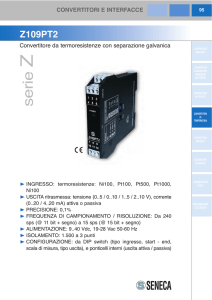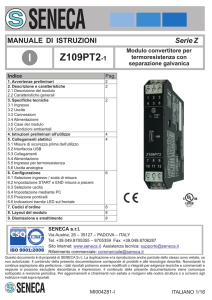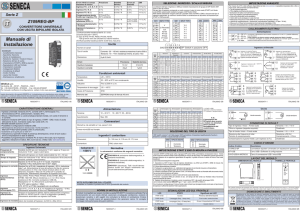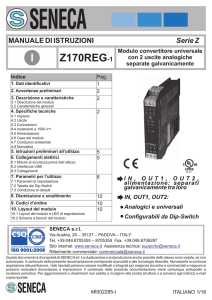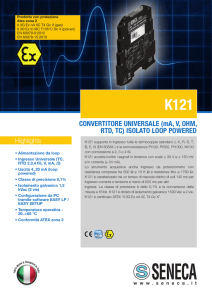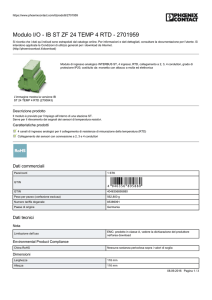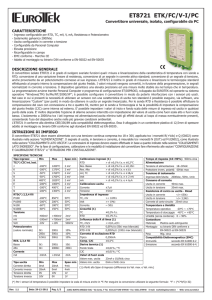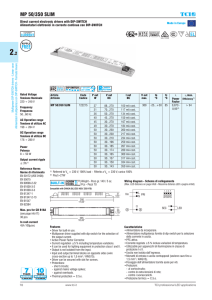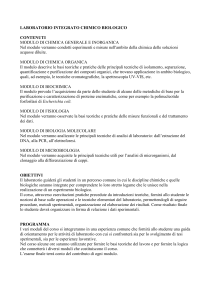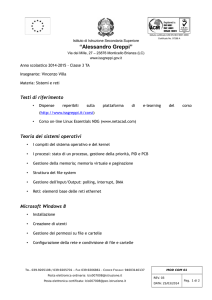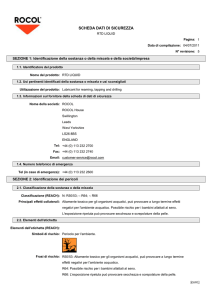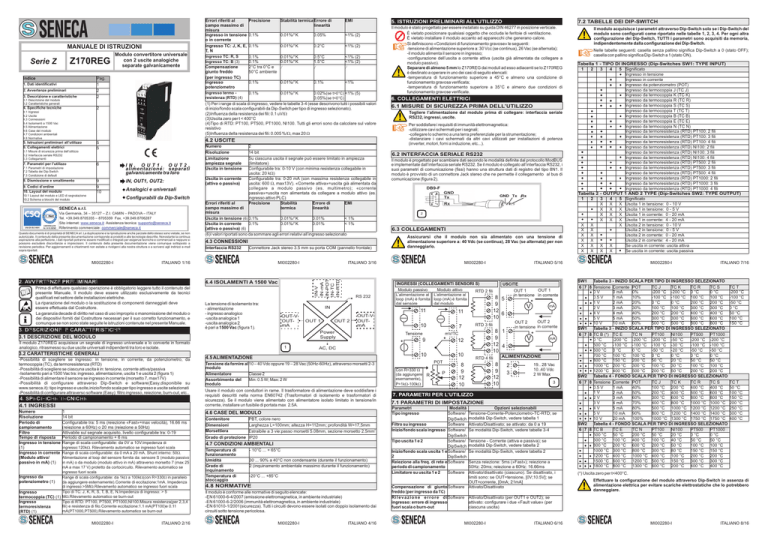
MANUALE DI ISTRUZIONI
Indice
1. Dati identificativi
2. Avvertenze preliminari
3. Descrizione e caratteristiche
3.1 Descrizione del modulo
3.2 Caratteristiche generali
Pag.
1
2
2
4.1 Ingressi
4.2 Uscite
4.3 Connessioni
4.4 Isolamenti a 1500 Vac
4.5 Alimentazione
4.6 Case del modulo
4.7 Condizioni ambientali
4.8 Normative
5. Istruzioni preliminari all’utilizzo
6. Collegamenti elettrici
6.1 Misure di sicurezza prima dell’utilizzo
6.2 Interfaccia seriale RS232
6.3 Collegamenti
7. Parametri per l’utilizzo
7.1 Parametri di impostazione
7.2 Tabella dei Dip-Switch
7.3 Condizione di default
8. Dismissione e smaltimento
9. Codici d’ordine
10. Layout del modulo
10.1 Layout del modulo e LED di segnalazione
10.2 Schema a blocchi del modulo
9
9
10
IN, OUT1, OUT2,
alimentazione: separati
galvanicamente tra loro
IN, OUT1, OUT2:
Numero
Risoluzione
Limitazione
ampiezza segnale
Uscita in tensione
Uscita in corrente
(attiva o passiva)
Analogici e universali
Configurabili da Dip-Switch
SENECA s.r.l.
Via Germania, 34 – 35127 – Z.I. CAMIN – PADOVA – ITALY
Tel. +39.049.8705355 – 8705359 Fax. +39.049.8706287
Sito internet: www.seneca.it Assistenza tecnica: [email protected]
Riferimento commerciale: [email protected]
Questo documento è di proprietà di SENECA srl. La duplicazione e la riproduzione anche parziale dello stesso sono vietate, se non
autorizzate. Il contenuto della presente documentazione corrisponde ai prodotti e alle tecnologie descritte. Nonostante la continua
aspirazione alla perfezione, i dati riportati potranno essere modificati o integrati per esigenze tecniche e commerciali e neppure si
possono escludere discordanze e imprecisioni. Il contenuto della presente documentazione viene comunque sottoposto a
revisione periodica. Per aggiornamenti e chiarimenti non esitate a rivolgervi alla nostra struttura o a scriverci agli indirizzi e-mail
sopra riportati.
MI002280-I
0.01%/°K
0.05%
<1% (2)
0.01%/°K
0.2°C
<1% (2)
0.01%/°K
0.01%/°K
/
0.5°C
1.5°C
/
<1% (2)
<1% (2)
/
0.01%/°K
0.1%
<1%
0.01%/°K
2
14 bit
Su ciascuna uscita il segnale può essere limitato in ampiezza
(limitatore)
Configurabile tra: 0-10 V (con minima resistenza collegabile in
uscita: 20 kW
)
Configurabile tra: 0-20 mA (con massima resistenza collegabile in
uscita: 600 W
,
max13V). «Corrente attiva»=uscita già alimentata da
collegare a modulo passivo (es. multimetro); «corrente
passiva»=uscita non alimentata da collegare a modulo attivo (es.
ingresso attivo PLC)
Precisione
Stabilità
Errore di
EMI
termica
linearità
Errori riferiti al
campo massimo di
misura
Uscita in tensione (6) 0.1%
0.01%/°K
0.01%
< 1%
Uscita in corrente
0.1%
0.01%/°K
0.01%
< 1%
(attiva o passiva) (6)
(6)I valori riportati sono da sommare agli errori relativi all’ingresso selezionato
Interfaccia RS232
4.4 ISOLAMENTI A 1500 Vac
Prima di effettuare qualsiasi operazione è obbligatorio leggere tutto il contenuto del
presente Manuale. Il modulo deve essere utilizzato esclusivamente da tecnici
qualificati nel settore delle installazioni elettriche.
La riparazione del modulo o la sostituzione di componenti danneggiati deve
essere effettuata dal Costruttore.
La garanzia decade di diritto nel caso di uso improprio o manomissione del modulo o
dei dispositivi forniti dal Costruttore necessari per il suo corretto funzionamento, e
comunque se non sono state seguite le istruzioni contenute nel presente Manuale.
3. DESCRIZIONE E CARATTERISTICHE
3.1 DESCRIZIONE DEL MODULO
La tensione di isolamento tra:
- alimentazione
- ingresso analogico
-uscita analogica 1
-uscita analogica 2
è pari a 1500 Vac (figura 1).
6.1 MISURE DI SICUREZZA PRIMA DELL’UTILIZZO
Togliere l’alimentazione dal modulo prima di collegare: interfaccia seriale
RS232, ingressi, uscite.
Per soddisfare i requisiti di immunità elettromagnetica:
-utilizzare cavi schermati per i segnali;
-collegare lo schermo a una terra preferenziale per la strumentazione;
-distanziare i cavi schermati da altri cavi utilizzati per installazioni di potenza
(inverter, motori, forni a induzione, etc...).
3.2 CARATTERISTICHE GENERALI
-Possibilità di scegliere se ingresso: in tensione, in corrente, da potenziometro, da
termocoppia (TC), da termoresistenza (RTD)
-Possibilità di scegliere se ciascuna uscita è in: tensione, corrente attiva/passiva
-Isolamento pari a 1500 Vac tra: ingresso, alimentazione, uscita 1 e uscita 2 (figura 1)
-Possibilità di alimentare il sensore se ingresso in corrente (morsetto 7, max17V)
-Possibilità di configurare attraverso Dip-Switch e software(Easy,disponibile su
www.seneca.it): tipo ingresso e uscite,inizio/fondo scala per tipo ingresso e uscite selezionati
-Possibilità di configurare attraverso software (Easy): filtro ingresso, reiezione, burn-out, etc..
4. SPECIFICHE TECNICHE
4.1 INGRESSI
1
14 bit
Configurabile tra: 5 ms (reiezione «Fast»=max velocità), 16.66 ms
(reiezione a 60Hz) o 20 ms (reiezione a 50Hz)
Attivabile sul segnale acquisito, livello configurabile tra: 0-19
Periodo di campionamento + 6 ms
Range di scala configurabile: da 0V a 10V.Impedenza di
ingresso:120kW
.
Rilevamento automatico se ingresso fuori scala
Range di scala configurabile: da 0 mA a 20 mA. Shunt interno: 50W
.
Alimentazione al loop del sensore fornita da: sensore S (modulo passivo
in mA) o da modulo (modulo attivo in mA) attraverso morsetto 7 (max 25
mA a max 17 V) protetto da cortocircuito. Rilevamento automatico se
ingresso fuori scala
Ingresso da
Range di scala configurabile: da 1kW
a 100kW
(con R=330W
in parallelo
potenziometro (1)
da aggiungere esternamente).Corrente di eccitazione:1mA. Impedenza
di ingresso:>5MW
.
Rilevamento automatico se ingresso fuori scala
Tipo di TC: J, K, R, S, T, B, E, N.Impedenza di ingresso: > 5
Ingresso
.
Rilevamento automatico se burn-out
termocoppia (TC) (1) MW
Tipo di RTD: PT100, PT500, PT1000,NI100.Misura resistenza(per 2,3,4
Ingresso
fili) e resistenza di filo.Corrente eccitazione:1.1 mA(PT100)e 0.11
termoresistenza
mA(PT1000,PT500).
Rilevamento automatico se burn-out
(RTD) (1)
ITALIANO 2/16
6.2 INTERFACCIA SERIALE RS232
Il modulo è progettato per scambiare dati secondo le modalità definite dal protocollo ModBUS
e implementate dall’interfaccia seriale RS232. Se il modulo è collegato all’interfaccia RS232, i
suoi parametri di comunicazione (fissi) hanno una struttura dati di registro del tipo 8N1. Il
modulo è provvisto di un connettore Jack stereo che ne permette il collegamento al bus di
comunicazione (figura 2).
GND Tx
6.3 COLLEGAMENTI
Assicurarsi che il modulo non sia alimentato con una tensione di
alimentazione superiore a: 40 Vdc (se continua), 28 Vac (se alternata) per non
danneggiarlo.
MI002280-I
ITALIANO 3/16
OUT 1
RS 232
L’alimentazione al L’alimentazione al
loop (mA) è fornita loop (mA) è fornita
dal modulo
dal sensore
11
OUT-V
OUTmA
10
Power
Supply
+
1
10
4.5 ALIMENTAZIONE
Usare il modulo con conduttori in rame. Il trasformatore di alimentazione deve soddisfare i
requisiti descritti nella norma EN60742 (Trasformatori di isolamento e trasformatori di
sicurezza). Se il modulo viene alimentato con alimentatore isolato limitato in tensione/in
corrente, installare un fusibile di portata max 2.5A.
4.6 CASE DEL MODULO
PBT, colore nero
Larghezza L=100mm; altezza H=112mm; profondità W=17,5mm
Estraibile a 3 vie:passo morsetti 5.08mm, sezione morsetto 2.5mm2
IP20
4.7 CONDIZIONI AMBIENTALI
Temperatura di
funzionamento
Umidità
Grado di
inquinamento
Temperatura di
stoccaggio
- 10°C ... + 65°C
30 ... 90% a 40°C non condensante (durante il funzionamento)
2 (inquinamento ambientale massimo durante il funzionamento)
-20°C ... +85°C
4.8 NORMATIVE
Il modulo è conforme alle normative di seguito elencate:
-EN 61000-6-4/2007 (emissione elettromagnetica, in ambiente industriale)
-EN 61000-6-2/2006 (immunità elettromagnetica, in ambiente industriale)
-EN 61010-1/2001(sicurezza). Tutti i circuiti devono essere isolati con doppio isolamento dai
circuiti sotto tensione pericolosa.
MI002280-I
12
AC, DC
Tensione da fornire al 10 – 40 Vdc oppure 19 – 28 Vac (50Hz-60Hz), attraverso morsetti 2-3
modulo
Alimentatore
Classe 2
Assorbimento del
Min: 0.5 W; Max: 2 W
modulo
Contenitore
Dimensioni
Morsettiera
Grado di protezione
+
ITALIANO 4/16
10
POT
Con R=330 W
(da aggiungere R
esernamente),
P=1kW
-100kW
P
RTD 4 fili
8
9
12
10
8
9
12
10
+
mA
OUT 2
OUT 2
in tensione in corrente
8 1
9
12 4
10
mV/TC
9
V
RTD 3 fili
7
Tensione
USCITE
OUT 1
OUT 1
in tensione in corrente
8 5
9
12
6
10
11
V
+
mA
ALIMENTAZIONE
2
3
19.. 28 Vac
10..40 Vdc
2 W Max
3
7. PARAMETRI PER L’UTILIZZO
7.1 PARAMETRI DI IMPOSTAZIONE
Parametri
Tipo ingresso
Modalità
Software/
DipSwitch
Filtro su ingresso
Software
Inizio/fondo scala ingresso Software/
DipSwitch
Tipo uscita 1 e 2
Software/
DipSwitch
Inizio/fondo scala uscita 1 e Software/
2
DipSwitch
Reiezione alla freq. di rete e Software
periodo di campionamento
Limitatore su uscita 1 e 2
Software
Opzioni selezionabili
Tensione-Corrente-Potenziometro-TC-RTD; se
modalità Dip-Switch, vedere tabella 1
Attivato/Disattivato; se attivato: da 0 a 19
Se modalità Dip-Switch, vedere tabelle 3-4
Tensione - Corrente (attiva e passiva); se
modalità Dip-Switch, vedere tabella 2
Se modalità Dip-Switch, vedere tabella 2
Senza reiezione: 5ms (»Fast»); reiezione a
50Hz: 20ms; reiezione a 60Hz: 16.66ms
Attivato/disattivato (ciascuno). Se disattivato, i
limiti sono: se OUT=tensione, [0V;10.5V]; se
OUT=corrente, [0mA; 21mA]
Compensazione di giunto Software Attivato/Disattivato
freddo (per ingresso da TC)
R i l e v a z i o n e e r r o r e d i Software Attivato/Disattivato (per OUT1 e OUT2); se
ingresso: errore di ingresso
attivato: configurare i due «Fault value» (per
fuori scala o burn-out
ciascuna uscita)
MI002280-I
Il modulo acquisisce i parametri attraverso Dip-Switch solo se i Dip-Switch del
modulo sono configurati come riportato nelle tabelle 1, 2, 3, 4. Per ogni altra
configurazione dei Dip-Switch, TUTTI i parametri sono acquisiti da memoria,
indipendentemente dalla configurazione dei Dip-Switch.
Nelle tabelle seguenti: casella senza pallino significa Dip-Switch a 0 (stato OFF);
casella con pallino significa Dip-Switch a 1 (stato ON).
Tabella 1 - TIPO DI INGRESSO (Dip-Switches SW1: TYPE INPUT)
1
2
3
4
5 Significato
Ingresso in tensione
Ingresso in corrente
Ingresso da potenziometro (POT)
Ingresso da termocoppia J (TC J)
Ingresso da termocoppia K (TC K)
Ingresso da termocoppia R (TC R)
Ingresso da termocoppia S (TC S)
Ingresso da termocoppia T (TC T)
Ingresso da termocoppia B (TC B)
Ingresso da termocoppia E (TC E)
Ingresso da termocoppia N (TC N)
Ingresso da termoresistenza (RTD) PT100: 2 fili
Ingresso da termoresistenza (RTD) PT100: 3 fili
Ingresso da termoresistenza (RTD) PT100: 4 fili
Ingresso da termoresistenza (RTD) NI100: 2 fili
Ingresso da termoresistenza (RTD) NI100: 3 fili
Ingresso da termoresistenza (RTD) NI100: 4 fili
Ingresso da termoresistenza (RTD) PT500: 2 fili
Ingresso da termoresistenza (RTD) PT500: 3 fili
Ingresso da termoresistenza (RTD) PT500: 4 fili
Ingresso da termoresistenza (RTD) PT1000: 2 fili
Ingresso da termoresistenza (RTD) PT1000: 3 fili
Ingresso da termoresistenza (RTD) PT1000: 4 fili
Tabella 2 - OUTPUT 1 AND 2 TYPE (Dip-Switches SW2: TYPE OUTPUT)
1
2
3
4
5 Significato
X
X
X Uscita 1 in tensione: 0 - 10 V
X
X
X Uscita 1 in tensione: 0 - 5 V
X
X
X Uscita 1 in corrente: 0 - 20 mA
X
X
X Uscita 1 in corrente: 4 - 20 mA
X
X
X Uscita 2 in tensione: 0 - 10 V
X
X
Uscita 2 in tensione: 0 - 5 V
X
X
Uscita 2 in corrente: 0 - 20 mA
X
X
Uscita 2 in corrente: 4 - 20 mA
X
X
X
X
Se uscita in corrente: uscita attiva
X
X
X
X
Se uscita in corrente: uscita passiva
MI002280-I
ITALIANO 5/16
INGRESSI (COLLEGAMENTI SENSORI S)
Modulo attivo
Modulo passivo
RTD 2 fili
OUT 2
Rx
2
IN
OUT-V
OUTmA
Il modulo Z170REG acquisisce un segnale di ingresso universale e lo converte in formato
analogico, ritrasmesso su due uscite universali indipendenti tra loro e isolate.
MI002280-I
6. COLLEGAMENTI ELETTRICI
Connettore Jack stereo 3.5 mm su porta COM (pannello frontale)
MI002280-I
7.2 TABELLE DEI DIP-SWITCH
Il modulo è stato progettato per essere installato su guida DIN 46277 in posizione verticale.
È vietato posizionare qualsiasi oggetto che occluda le feritoie di ventilazione.
È vietato installare il modulo accanto ad apparecchi che generano calore.
Si definiscono «Condizioni di funzionamento gravose» le seguenti:
-tens
-tensione di alimentazione superiore a: 30 Vcc (se continua), 26 Vac (se alternata);
-il modulo alimenta il sensore in ingresso;
-configurazione dell’uscita a corrente attiva (uscita già alimentata da collegare a
modulo passivo).
Separare di almeno 5 mm lo Z170REG dai moduli ad esso adiacenti se lo Z170REG
è destinato a operare in uno dei casi di seguito elencati:
-temperatura di funzionamento superiore a 45°C e almeno una condizione di
funzionamento gravosa verificata;
-temperatura di funzionamento superiore a 35°C e almeno due condizioni di
funzionamento gravose verificate.
4.3 CONNESSIONI
ITALIANO 1/16
2. AVVERTENZE PRELIMINARI
Numero
Risoluzione
Periodo di
campionamento
Filtro
Tempo di risposta
Ingresso in tensione
(1)
Ingresso in corrente
(Modulo attivo/
passivo in mA) (1)
5. ISTRUZIONI PRELIMINARI ALL’UTILIZZO
4.2 USCITE
5
5
6
EMI
0.02%(se t>0°C) <1% (5)
resistenza (RTD) (4)
0.05%(se t<0°C)
(1) Per i range di scala di ingresso, vedere le tabelle 3-4 (esse descrivono tutti i possibili valori
di inizio/fondo scala configurabili da Dip-Switch per tipo di ingresso selezionato).
(2)Influenza della resistenza dei fili: 0.1 uV/W
(3)Uscita zero per t < 400°C
(4)Tipo di RTD: PT100, PT500, PT1000, NI100. Tutti gli errori sono da calcolare sul valore
resistivo
(5)Influenza della resistenza dei fili: 0.005 %/W
, max 20 W
2
4. Specifiche tecniche
Stabilità termica Errore di
linearità
IN-V
IN-mA
IN-POT
IN-TC
IN-RTD
Z170REG
Serie Z
Modulo convertitore universale
con 2 uscite analogiche
separate galvanicamente
Errori riferiti al
Precisione
campo massimo di
misura
Ingresso in tensione 0.1%
o in corrente
Ingresso TC: J, K, E, 0.1%
T, N
Ingresso TC: R, S
0.1%
Ingresso TC: B (3)
0.1%
Compensazione
2°C tra 0°C e
giunto freddo
50°C ambiente
(per ingresso TC)
Ingresso
0.1%
potenziometro
Ingresso termo 0.1%
ITALIANO 6/16
ITALIANO 7/16
SW1 Tabella 3 - INIZIO SCALA PER TIPO DI INGRESSO SELEZIONATO
6 7 8 Tensione Corrente POT
TC J
TC K
TC R
TC S
0V
0 mA
0%
-200 °C -200 °C 0 °C
0 °C
0.5 V
1 mA
10%
-100 °C -100 °C 100 °C 100 °C
1V
0 °C
2 mA
20%
0 °C
200 °C 200 °C
2V
3 mA
30%
100 °C 100 °C 300 °C 300 °C
4V
4 mA
40%
200 °C 200 °C 400 °C 400 °C
5V
5 mA
50%
300 °C 300 °C 600 °C 600 °C
10 V
10 mA
60%
500 °C 500 °C 800 °C 800 °C
SW1 Tabella 3 - INIZIO SCALA PER TIPO DI INGRESSO SELEZIONATO
6 7 8 TC B (*) TC E
TC N
PT100
NI100
PT500
PT1000
0 °C
-200 °C -200 °C -200 °C -50 °C
-200 °C -200 °C
500 °C -100 °C -100 °C -100 °C -30 °C
-100 °C -100 °C
600 °C 0 °C
0 °C
-50 °C
-20 °C
-50 °C
-50 °C
700 °C 100 °C 100 °C 0 °C
0 °C
0 °C
0 °C
800 °C 150 °C 200 °C 50 °C
20 °C
50 °C
50 °C
1000 °C 200 °C 300 °C 100 °C 30 °C
100 °C 100 °C
1200 °C 400 °C 500 °C 200 °C 50 °C
200 °C 200 °C
SW2 Tabella 4 - FONDO SCALA PER TIPO DI INGRESSO SELEZIONATO
6 7 8 Tensione Corrente POT
TC J
TC K
TC R
TC S
0.5 V
1 mA
40%
100 °C 200 °C 400 °C 400 °C
1V
2 mA
50%
200 °C 400 °C 600 °C 600 °C
2V
3 mA
60%
300 °C 600 °C 800 °C 800 °C
3V
4 mA
70%
400 °C 800 °C 1000 °C 1000 °C
4V
5 mA
80%
500 °C 1000 °C 1200 °C 1200 °C
5V
10 mA
90%
800 °C 1200 °C 1400 °C 1400 °C
10 V
20 mA
100%
1000 °C 1300 °C 1750 °C 1750 °C
SW2 Tabella 4 - FONDO SCALA PER TIPO DI INGRESSO SELEZIONATO
6 7 8 TC B
TC E
TC N
PT100
NI100
PT500
PT1000
500 °C 50 °C
200 °C 50 °C
20 °C
0 °C
0 °C
600 °C 100 °C 400 °C 100 °C 40 °C
50 °C
50 °C
800 °C 200 °C 600 °C 200 °C 50 °C
100 °C 100 °C
150 °C 150 °C
1000 °C 300 °C 800 °C 300 °C 80 °C
1200 °C 400 °C 1000 °C 400 °C 100 °C 200 °C 200 °C
1500 °C 600 °C 1200 °C 500 °C 150 °C 300 °C 300 °C
1800 °C 800 °C 1300 °C 600 °C 200 °C 400 °C 400 °C
TC T
-200 °C
-100 °C
-50 °C
0 °C
50 °C
100 °C
150 °C
TC T
50 °C
100 °C
150 °C
200 °C
250 °C
300 °C
400 °C
(*) Uscita zero per t<400°C.
Effettuare la configurazione del modulo attraverso Dip-Switch in assenza di
alimentazione elettrica per evitare scariche elettrostatiche che lo potrebbero
danneggiare.
MI002280-I
ITALIANO 8/16
MI002280-I
Smaltimento dei rifiuti elettrici ed elettronici (applicabile nell’Unione Europea e negli altri paesi con
raccolta differenziata). Il simbolo presente sul prodotto o sulla confezione indica che il prodotto
non verrà trattato come rifiuto domestico. Sarà invece consegnato al centro di raccolta autorizzato
per il riciclo dei rifiuti elettrici ed elettronici. Assicurandovi che il prodotto venga smaltito in modo
adeguato, eviterete un potenziale impatto negativo sull’ambiente e la salute umana, che potrebbe
essere causato da una gestione non conforme dello smaltimento del prodotto. Il riciclaggio dei
materiali contribuirà alla conservazione delle risorse naturali. Per ricevere ulteriori informazioni
più dettagliate Vi invitiamo a contattare l’ufficio preposto nella Vostra città, il servizio per lo
smaltimento dei rifiuti o il fornitore da cui avete acquistato il prodotto.
9. CODICI D’ORDINE
Descrizione
Duplicatore universale con separazione galvanica
Software di configurazione del modulo
Cavo di connessione per comunicazione RS232 (da DB9-F)
+2.5%
IN
Fondo
scala
ingresso
Range di scala
-2.5%
IN
LED ALARM
acceso spento
+2.5%
Se l’ampiezza del segnale di ingresso IN supera anche i limiti hardware del modulo (vedere la
tabella seguente), il software segnala errore di fail presente.
MI002280-I
ITALIANO 11/16
Tipo di ingresso
Tensione
Corrente
Potenziometro
Termocoppia
Limiti hardware del modulo
0V; 10.5V
0mA; 21mA
0; 100%
Se TC J: -210°C; 1200°C. Se TC K: -270°C; 1370°C. Se TC R: 50°C;1760°C. Se TC S: -50°C;1760°C. Se TC T: -270°C; 400°C. Se
TC B: 0;1820°C. Se TC E: -270°C; 1000°C. Se TC N: -270°C; 1300°C
Termoresistenza
Se RTD=NI100: -60°C; 250°C
Se RTD=PT100, RTD=PT500, RTD=PT1000: -200°C; 600°C
Se il LED ALARM è acceso (errore di ingresso presente o errore di fail presente) e la
diagnostica su ingresso è attivata, il modulo scrive nelle uscite il valore Fault value.
10
-
LIMITATORE
FILTRO
0-19
6
1
Blocco
FILTRO 0-19
A/A
LIMITATORE
IN
OUT 1
+
5
9
A
A
8
LIMITATORE
4
12
INGRESSO
Inizio
scala
ingresso
11
Modulo passivo
(mA)
Modulo attivo (mA)
TENSIONE
TC
POT/RTD
-2.5%
LED ALARM
spento
acceso
+
IN
Range di scala
USCENTE ENTRANTE USCENTE
IN
Fondo
scala
ingresso
POWER
SUPPLY
3
OUT 2
Inizio
scala
ingresso
ITALIANO 9/16
8. DISMISSIONE E SMALTIMENTO
Codice d’ordine
Z170REG
Easy Z170REG
PM001601
Se l’ampiezza del segnale di ingresso IN è compresa tra inizio scala ingresso e fondo scala
ingresso, l’uscita è direttamente proporzionale all’ingresso.
Se l’ampiezza del segnale di ingresso IN supera l’intervallo [inizio scala ingresso-2.5% del
range di scala, fondo scala ingresso+2.5% del range di scala], il LED ALARM commuta da
spento ad acceso e il software segnala errore di ingresso presente.
Se l’ampiezza del segnale di ingresso IN diminuisce entro l’intervallo [inizio scala ingresso2.5% del range di scala, fondo scala ingresso+2.5% del range di scala], il LED ALARM
commuta da acceso a spento e il software segnala errore di ingresso assente.
7
2
19...28 Vac
10...40 Vdc
-
8N1
9600 (fisso)
1 (fisso)
Struttura dati di registro pari a 8N1 significa che il registro è strutturato nel seguente
modo: 8 bit di dati, nessun controllo di parità (N), 1 bit di stop.
La condizione di default per i parametri di configurazione del modulo è riportata nella tabella
seguente (se modalità di configurazione da software).
Tipo ingresso
Corrente
Filtro su ingresso (segnale acquisito)
Disattivato
Inizio /Fondo scala ingresso
0 [mA]/20[mA]
Tipo uscita 1 e uscita 2
Corrente attiva
Inizio scala uscita 1 e 2
0 [mA]
Fondo scala uscita 1 e 2
20 [mA]
Limitatore su uscita 1 e 2
Disattivati
Estremo inferiore limitatore dell’uscita 1 e 2
0 [mA]
Estremo superiore limitatore dell’uscita 1 e 2 20 [mA]
Reiezione alla frequenza di rete/periodo di Disattivata/periodo di campionamento=5ms
campionamento
Compensazione di giunto freddo (per ingresso Disattivata
da TC)
Rilevazione errore in ingresso: errore di Disattivata/Fault value=0[mA]
ingresso fuori scala (se ingresso: tensione,
corrente, potenziometro); errore di burn-out
(se ingresso: TC, RTD)/ Fault value
La condizione di default per i parametri di configurazione del modulo non configurabili con i
Dip-Switch è riportata nella tabella seguente (se modalità di configurazione da Dip-Switch).
Filtro su ingresso (segnale acquisito)
Disattivato
Limitatore su uscita 1 e 2
Disattivati (solo se uscita in corrente 420mA: limitatore attivato, estremo inferioresuperiore limitatore dell’uscita:3.6-20.4mA)
Reiezione alla frequenza di rete/periodo di Se IN=tensione, corrente, potenziometro: no
campionamento
reiezione, periodo di campionamento=5ms
se IN=TC, RTD: reiezione=50Hz, periodo di
campionamento =20ms
Compensazione di giunto freddo (per ingresso Attivata
da TC)
Rilevazione errore di ingresso/Fault value
Se IN=tensione, corrente, potenziometro:
disattivata; se IN=TC, RTD: attivata, Fault
value= fondo scala di uscita+5%del range di
scala di uscita
I valori dei parametri di impostazione configurati da Dip-Switch hanno priorità
rispetto i valori memorizzati in memoria EEPROM.
Questa pagina è stata intenzionalmente lasciata vuota.
10.2 SCHEMA A BLOCCHI DEL MODULO
ENTRANTE
RS232
La condizione «Stato di allarme presente» corrisponde alla presenza di almeno uno tra gli
errori di seguito elencati:
Tipo di errore
Descrizione
Tipo di ingresso
interessato
Errore di ingresso L’ampiezza del segnale acquisito in ingresso è Tensione, corrente,
inferiore(superiore) al valore di inizio scala potenziometro,
termocoppia,
(fondo scala) di ingresso oppure il sensore in termoresistenza
ingresso al modulo è danneggiato (TC, RTD)
Errore di perdita /
Tutti
dati in memoria
EEPROM
Errore di
Il sensore di giunto freddo interno al modulo è Termocoppia
acquisizione
danneggiato
temperatura in
ingresso
USCITE
La condizione di default per i parametri di comunicazione del modulo è riportata nella tabella
seguente.
Struttura dati di
Comunicazione
Velocità di
Indirizzo del nodo
registro
comunicazione
TENSIONE
CORRENTE
7.3 CONDIZIONE DI DEFAULT
5
Significato del blocco (figura 5)
Filtro a 20 livelli sul segnale acquisito in ingresso
Convertitore Analogico/Analogico
Limitatore dell’ampiezza del segnale in uscita
MI002280-I
ITALIANO 13/16
Questa pagina è stata intenzionalmente lasciata vuota.
MI002280-I
ITALIANO 15/16
Questa pagina è stata intenzionalmente lasciata vuota.
10. LAYOUT DEL MODULO
10.1 LAYOUT DEL MODULO E LED DI SEGNALAZIONE
DIMENSIONI DEL MODULO
PANNELLO FRONTALE
1 2 3
4 5 6
PWR
112 mm
ALARM
COM
S
17,5 mm
Z170REG
7 8 9
10 11 12
4
100,0 mm
Il pannello frontale del modulo comprende 2 LED, lo stato di ciascuno dei quali corrisponde a
importanti condizioni di funzionamento del modulo stesso (figura 4).
LED
PWR
Stato del LED
Acceso (luce verde)
ALARM Acceso (luce gialla)
Spento
Significato del LED
Il modulo è alimentato correttamente
Stato di allarme presente
Stato di allarme assente
MI002280-I
ITALIANO 10/16
MI002280-I
ITALIANO 12/16
MI002280-I
ITALIANO 14/16
MI002280-I
ITALIANO 16/16
Errors related to max Accuracy
measuring range
USER MANUAL
Universal converter module
with galvanic insulation
between 2 analog outputs
Page
1
2
2
Chapter index
1. Identification data
2. Preliminary warnings
3. Description and characteristics
3.1 Module description
3.2 General characteristics and features
4. Technical specifications
4.1 Inputs
4.2 Outputs
4.3 Connections
4.4 1500 Vac insulations
4.5 Power supply
4.6 Module case
4.7 Environmental conditions
4.8 Standards
6
7.1 Setting parameters
7.2 Dip-Switch tables
7.3 Default configuration
8. Decommissioning and disposal
9. Purchase order code
10. Module layout
9
9
10
10.1 Module layout and signalling LEDs
10.2 Block diagram
Voltage or currentinput type
TC-input type: J, K,
E, T, N
TC-input type: R, S
TC-input type: B (3)
Cold junction
compensation
(for TC-input type)
POT-input type
0.1%
0.01%/°K
0.05%
<1% (2)
0.1%
0.01%/°K
0.2°C
<1% (2)
0.1%
0.1%
2°C between
0-50°C
0.01%/°K
0.01%/°K
/
0.5°C
1.5°C
/
<1% (2)
<1% (2)
/
0.1%
0.01%/°K
0.1%
<1%
RTD-input type (4)
0.1%
0.01%/°K
IN, OUT1,OUT2, power
supply are isolated (1500Vac)
IN, OUT1,OUT2 are:
Analog and universal
Number
Resolution
Signal-amplitude
limiting
Voltage-type OUT
Current-type OUT
(active or passive)
Setting by Dip-Switches
SENECA s.r.l.
Via Germania, 34 – 35127 – Z.I. CAMIN – PADOVA – ITALY
Tel. +39.049.8705355 – 8705359 Fax. +39.049.8706287
Internet site: www.seneca.it Technical assistance: [email protected]
Commercial reference: [email protected]
This document is property of SENECA srl. Duplication and reproduction of its are forbidden (though partial), if not authorized.
Contents of present documentation refers to products and technologies described in it. Though we strive for reach perfection
continually, all technical data contained in this document may be modified or added due to technical and commercial needs; it’s
impossible eliminate mismatches and discordances completely. Contents of present documentation is anyhow subjected to
periodical revision. If you have any questions don’t hesitate to contact our structure or to write us to e-mail addresses as above
mentioned.
MI002280-E
2
14 bits
The output signal can be amplitude-limited by a «limiter» (for each
output)
Configurable between: 0-10 V (minimum resistence that can be
connected: 20kW
)
Configurable between: 0-20 mA (maximum resistence that can be
connected: 600 W
,
max13V). «Active current»=the output: already
powered on, needs to be connected to the passive module (es.
multimeter); «passive current»=the output: powered off, needs to be
connected to the active module (es. active input of a PLC)
Accuracy
Thermal
Linearity error EMI
stability
Errors related to
max measuring
range
Voltage-type OUT(6) 0.1%
0.01%/°K
0.01%
Current-type OUT
0.1%
0.01%/°K
0.01%
(active or passive) (6)
(6)These values have to be added to the errors of the selected input.
Power off the module before connecting: RS232 serial interface, input,
outputs.
To satisfy the electromagnetic compliance requirements:
-use shielded cables for signal transmittion;
-connect the shield to a earth wire used specifically for instrumentation;
-insert space between these shielded cables and other cables used for power
appliances (inverters, motors, induction ovens, etc...).
No warranty is guaranteed in connection with faults resulting from improper use, from
modifications or repairs carried out by Manufacturer-unauthorised personnel on the
module, or if the content of this user Manual is not followed.
3. DESCRIPTION AND CHARACTERISTICS
3.1 MODULE DESCRIPTION
The isolation voltage between:
-power supply
-analog input
-analog output 1
-analog output 2
is 1500 Vac (figure 1).
1
14 bits
Configurable between: 5 ms («Fast» rejection=max velocity), 16.66
ms (rejection to 60Hz) or 20 ms (rejection to 50Hz)
Level configurable between: 0(no filter is applied) - 19
Filter
Sampling time + 6 ms
Response time
Voltage-type IN(1)
Scale range is configurable:from 0V to 10V.Input impedance:120kW
.
Automatic detection if a over-scala input occurs
Current-type IN (mA- Scale range is configurable:from 0mA to 20mA.Internal shunt:50W
.
It’s
passive module/mA- possible to power the sensor by:itself(mA-passive module)or module(mAactive module) (1)
active module)using #7 screw terminal(max25mA to max17V,short-circuit
protected).Automatic detection if a over-scala input occurs
Potentiometer-type Scale range is configurable:from 1 kW
to 100 kW
(with parallel resistor
IN (1)
R= 330 W
to connect externally). Excitation current: 1 mA. Input
impedance: > 5 MW
.
Automatic detection if a over-scala input occurs
Thermocouple-type For TC type: J, K, R, S, T, B, E, N. Input impedance: > 5 MW
.
Automatic
IN (1)
detection if a burn-out occurs
For RTD type:PT100,PT500,PT1000,NI100.Resistance measure(for
RTD-type IN (1)
2,3,4-wires connection) and wire-resistance measure.Excitation
current:1.1 mA(PT100)and 0.11mA(PT1000, PT500).Automatic detection
if a burn-out occurs
Number
Resolution
Sampling time
1
ENGLISH 2/16
Power on the module with < 40 Vdc or < 28 Vac voltage supply. These upper
limits must not be exceeded to avoid serious damage to the module.
MI002280-E
ENGLISH 3/16
RS 232
OUT 1
The module
power the loop
(in mA)
The sensor
power the loop
(in mA)
11
OUT 2
OUT-V
OUTmA
10
+
AC, DC
+
10
10
POT
10 – 40 Vdc or 19 – 28 Vac (50Hz-60Hz), between 2-3 screw
terminals
Power-supply unit Class 2
Power consumption Min: 0.5 W; Max: 2 W
The power supply transformer must comply with EN60742 (Isoalated transformers and safety
transformers requirements). If the module is powered by an isolated limited voltage/limited
current power supply, install a 2.5A-max rated fuse.
4.6 MODULE CASE
PBT, black
Width W = 100 mm, Height H = 112mm, Depth D = 17.5 mm
2
Removable 3-way screw terminals: pitch 5.08mm, sections 2.5mm
IP20 (International Protection)
4.6 ENVIRONMENTAL CONDITIONS
With R=330 W
(it needs to be
R
added externally),
P=1kW
-100kW
4.7 STANDARDS
The module complies with the following standards:
-EN 61000-6-4/2007 (electromagnetic emission, in industrial enviroment)
-EN 61000-6-2/2006 (electromagnetic immunity, in industrial enviroment)
-EN 61010-1/2001(safety). All electrical circuits must be isolated with double isolation from
other circuits with dangerous voltage.
MI002280-E
ENGLISH 4/16
8
9
12
10
OUT 2
current
OUT 2
voltage
+
V
mA
POWER SUPPLY
2
3
19.. 28 Vac
10..40 Vdc
2 W Max
3
7.1 SETTING PARAMETERS
Parameters
Input type
Input filter
Input start/end scale
-10°C ... +65°C
-20°C ... +85°C
4-wire RTD
8
9
12
10
mA
7. PARAMETERS FOR USE
Output 1, 2 type
30 ... 90% to 40°C not condensing (during operation)
2 (during operation)
P
V
8 1
9
12 4
10
12
OUT 1
current
+
3-wire RTD
7
mV/TC
9
OUTPUTS
OUT 1
voltage
8 5
9
12
6
10
11
Voltage
Supply voltage
Operating
temperature
Humidity
Max enviroment
pollution degree
Storage temperature
Table 1 - INPUT TYPE (Dip-Switches SW1: TYPE INPUT)
5 Meaning
Voltage-type input
Current-type input
Potentiometer-type input (POT)
Thermocouple J-type input (TC J)
Thermocouple K-type input (TC K)
Thermocouple R-type input (TC R)
Thermocouple S-type input (TC S)
Thermocouple T-type input (TC T)
Thermocouple B-type input (TC B)
Thermocouple E-type input (TC E)
Thermocouple N-type input (TC N)
PT100 (RTD)-type input: 2 wires connection
PT100 (RTD)-type input: 3 wires connection
PT100 (RTD)-type input: 4 wires connection
NI100 (RTD)-type input: 2 wires connection
Ni100 (RTD)-type input: 3 wires connection
Ni100 (RTD)-type input: 4 wires connection
PT500 (RTD)-type input: 2 wires connection
PT500 (RTD)-type input: 3 wires connection
PT500 (RTD)-type input: 4 wires connection
PT1000 (RTD)-type input: 2 wires connection
PT1000 (RTD)-type input: 3 wires connection
PT1000 (RTD)-type input: 4 wires connection
Table 2 - OUTPUT 1 AND 2 TYPE (Dip-Switches SW2: TYPE OUTPUT)
4
1
2
3
5 Meaning
X
X
X Voltage-type output 1: 0 - 10 V
X
X
X Voltage-type output 1: 0 - 5 V
X
X Current-type output 1: 0 - 20 mA
X
X
X
X Current-type output 1: 4 - 20 mA
X
X
X Voltage-type output 2: 0 - 10 V
X
X
Voltage-type output 2: 0 - 5 V
X
X
Current-type output 2: 0 - 20 mA
X
X
Current-type output 2: 4 - 20 mA
X
X
X
X
If current-type output: active current
X
If current-type output: passive current
X
X
X
1
2
3
4
Output 1,2 start/end
scale
Output 1,2 limiters
Modality
Options
Software/ Voltage-Current-Potentiometer-TC-RTD; if DipDipSwitch Switch modality, see table 1
Software Activated/Disactivated;if activated: from 0 to 19
Software/
DipSwitch
Software/
DipSwitch
Software/
DipSwitch
Software
If Dip-Switch modality, see tables 3-4
Voltage-Current (active,passive);if Dip-Switch
modality, see table 2
If Dip-Switch modality, see table 2
Activated/Disactivated; if deactivated, output limits
are: if OUT=voltage, [0V;10.5V]; if OUT=current,
[0mA; 21mA]
Network frequency
Software No rejection: 5ms («Fast»); 50Hz-rejection: 20ms;
rejection/sampling time
60Hz-rejection:16.66ms
(for TC-type input) Cold Software Activated/Disactivated
junction compensation
Detection of input fail: Software Activated/Disactivated (for OUT1 and OUT2); if
over-scala input error
activated: the two «Fault values» (for each output)
or burn-out error
have to be configured
MI002280-E
MI002280-E
ENGLISH 5/16
INPUTS (SENSORS «S» CONNECTION)
Active module
Passive module
2-wire RTD
4.5 POWER SUPPLY
Box
Dimensions
Terminal board
Protection class
Rx
6.3 CONNECTIONS
Power
Supply
3.2 GENERAL CHARACTERISTICS AND FEATURES
4. TECHNICAL SPECIFICATIONS
4.1 INPUTS
GND Tx
IN
OUT-V
OUTmA
The Z170REG module acquires 1 universal input signal and converts it to an analog format,
sent through 2 universal output signals (regardless and isolated with each other).
-It’s possible to choose if the input is: voltage type, current type, potentiometer type,
thermocouple(TC) type, RTD (Resistance Temperature Detector) type
-It’s possible to choose if each output is: voltage type, active/passive current type
-1500 Vac insulation between: input, power supply, output 1 and output 2 (figure 1)
-It’s possible to power the sensor if input is in current type modality (max17V)
-It’s possible to configure by Dip-Switch or by software(Easy, available on www.seneca.it)
modality: input-type, outputs-type, start/end scale of each selected input and outputs-type
-It’s possible to configure by software (Easy): input filter, rejection, burn-out, etc..
The module has a Jack stereo connector in order to connect its to RS232-bus
communication (figure 2).
2
< 1%
< 1%
MI002280-E
4.4 1500 Vac INSULATIONS
Before carrying out any operation it’s mandatory to read all the content of this user
Manual. Only electrical-skilled technicians can use the module described in this user
Manual.
Only the Manufacturer is authorized to repair the module or to replace damaged
components.
6.2 RS232 SERIAL INTERFACE
The module is designed to data interchange according to the ModBUS protocol rules,
implemented by RS232 serial interface. If the module is connected to RS232 interface-port ,
its (unchangeable) communication parameters have a register data structure equal to 8N1.
The module acquires the parameters through Dip-Switches, if the module DipSwitches are configurated as shown in the following tables 1, 2, 3, 4. For
whatever other Dip-Switches configuration, ALL parameters are acquired from
memory, regardless of the Dip-Switches configuration.
In the following tables: box without circle means Dip-Switch=0 (OFF state); box with
circle means Dip-Switch=1 (ON state).
Jack stereo 3.5mm connector:plugs into COMport(front-side panel)
ENGLISH 1/16
2. PRELIMINARY WARNINGS
MI002280-E
6. ELECTRICAL CONNECTIONS
6.1 SAFETY MEASURES BEFORE USE
4.3 CONNECTIONS
RS232 interface
7.2 DIP-SWITCH TABLES
The module is designed to be installed on DIN 46277 rail in vertical position.
It is forbidden to place anything that could obstructs the ventilation slits.
It is forbidden to install the module near heat sources.
«Severe operating conditions» are defined as follows:
-high power supply voltage: exceed 30 Vcc or exceed 26 Vac;
-the module power the sensor;
-active current-type output (the output: has already powered on, needs to be
connected to passive module).
If the modules are installed side by side, separate them by at least 5 mm in the
following cases:
-the operating temperature exceeds 45°C and at least one of the severe operating
conditions exists; or
-the operating temperature exceeds 35°C and at least two of the severe operating
conditions exist.
4.2 OUTPUTS
5
5
6.1 Safety measures before use
6.2 RS232 serial interface
6.3 Connections
7. Parameters for use
5. PRELIMINARY INSTRUCTIONS FOR USE
0.02%(if t>0°C) <1% (5)
0.05%(if t<0°C)
(1)For the input scale ranges, see tables 3-4 (description of all start/end-scale settings by DipSwithes modality for each selected-input type)
(2)Influence of wire resistance: 0.1 uV/W
(3)Output zero if t < 400°C
(4)For RTD type: PT100, PT500, PT1000, NI100. All the errors have to be calculated with
reference to resistive value
(5)Influence of wire resistance: 0.005 %/W
, max 20 W
2
5. Preliminary instructions for use
6. Electrical connections
Linearity error EMI
IN-V
IN-mA
IN-POT
IN-TC
IN-RTD
Z170REG
Z Line
Thermal
stability
ENGLISH 6/16
ENGLISH 7/16
SW1 Table 3 - START-SCALE VALUES FOR SELECTED INPUT TYPE
6 7 8 Voltage Current POT
TC J
TC K
TC R
TC S
0V
0 mA
0%
-200 °C -200 °C 0 °C
0 °C
0.5 V
1 mA
10%
-100 °C -100 °C 100 °C 100 °C
1V
0 °C
2 mA
20%
0 °C
200 °C 200 °C
2V
3 mA
30%
100 °C 100 °C 300 °C 300 °C
4V
4 mA
40%
200 °C 200 °C 400 °C 400 °C
5V
5 mA
50%
300 °C 300 °C 600 °C 600 °C
10 V
10 mA
60%
500 °C 500 °C 800 °C 800 °C
SW1 Table 3 - START-SCALE VALUES FOR SELECTED INPUT TYPE
6 7 8 TC B (*) TC E
TC N
PT100
NI100
PT500
PT1000
0 °C
-200 °C -200 °C -200 °C -50 °C
-200 °C -200 °C
500 °C -100 °C -100 °C -100 °C -30 °C
-100 °C -100 °C
600 °C 0 °C
0 °C
-50 °C
-20 °C
-50 °C
-50 °C
700 °C 100 °C 100 °C 0 °C
0 °C
0 °C
0 °C
800 °C 150 °C 200 °C 50 °C
20 °C
50 °C
50 °C
1000 °C 200 °C 300 °C 100 °C 30 °C
100 °C 100 °C
1200 °C 400 °C 500 °C 200 °C 50 °C
200 °C 200 °C
SW2 Table 4 - END-SCALE VALUES FOR SELECTED INPUT TYPE
6 7 8 Voltage Current POT
TC J
TC K
TC R
TC S
0.5 V
1 mA
40%
100 °C 200 °C 400 °C 400 °C
1V
2 mA
50%
200 °C 400 °C 600 °C 600 °C
2V
3 mA
60%
300 °C 600 °C 800 °C 800 °C
3V
4 mA
70%
400 °C 800 °C 1000 °C 1000 °C
4V
5 mA
80%
500 °C 1000 °C 1200 °C 1200 °C
5V
10 mA
90%
800 °C 1200 °C 1400 °C 1400 °C
10 V
20 mA
100%
1000 °C 1300 °C 1750 °C 1750 °C
SW2 Table 4 - END-SCALE VALUES FOR SELECTED INPUT TYPE
6 7 8 TC B
TC E
TC N
PT100
NI100
PT500
PT1000
500 °C 50 °C
200 °C 50 °C
20 °C
0 °C
0 °C
600 °C 100 °C 400 °C 100 °C 40 °C
50 °C
50 °C
800 °C 200 °C 600 °C 200 °C 50 °C
100 °C 100 °C
1000 °C 300 °C 800 °C 300 °C 80 °C
150 °C 150 °C
1200 °C 400 °C 1000 °C 400 °C 100 °C 200 °C 200 °C
1500 °C 600 °C 1200 °C 500 °C 150 °C 300 °C 300 °C
1800 °C 800 °C 1300 °C 600 °C 200 °C 400 °C 400 °C
TC T
-200 °C
-100 °C
-50 °C
0 °C
50 °C
100 °C
150 °C
TC T
50 °C
100 °C
150 °C
200 °C
250 °C
300 °C
400 °C
(*) Output zero if t < 400°C
Power off the module before configuring it by Dip-Switches to avoid serious
damage due to electrostatic discharges.
MI002280-E
ENGLISH 8/16
7.4 DEFAULT CONFIGURATION
If there is an alarm, the module has at least one of the following errors:
The default configuration for the communication parameters is shown in the following table.
Tipo di errore
Cold Junction compensation (for TC-type
input)
Detection of input fail: over-scala input error If IN=voltage, current, potentiometer:
(if voltage, current, potentiometer-type) or
deactivated; if IN=TC, RTD: activated, Fault
burn-out error(if TC, RTD-type)/Fault values values=output end scale+5% of output scala
range
IN
IN
Scala range
-2.5%
IN
Input
start
scale
LED ALARM
turned off turned on
+2.5%
Input
end
scale
Scala range
-2.5%
IN
LED ALARM
turned on turned off
+2.5%
If the amplitude of the acquired input signal IN exceeds the hardware module limits too (see
the following table), the software will also signal that there is a error fail.
Disposal of Electrical & Electronic Equipment (Applicable throughout the European Union and
other European countries with separate collections programs). This symbol, found on your
product or on its packaging, indicates that this product should not be treated as household waste
when you wish to dispose of it. Instead, it should be handed over to an applicable collection point
for the recycling of electrical & electronic equipment. By ensuring this product is disposed of
correctly, you will help prevent potential negative consequences to the environment and human
health, which could otherwise be caused by inappropriate disposal of this product. The recycling of
materials will help to conserve natural resources. For more detailed information about the
recycling of the product, please contact your local city office, waste disposal service of the retail
store where you purchased this product.
9. PURCHASE ORDER CODE
Order code
Z170REG
Easy Z170REG
PM001601
MI002280-E
ENGLISH 9/16
8. DECOMMISSIONING AND DISPOSAL
Input type
Voltage
Current
Potentiometer
Thermocouple
10
5
LIMITER 1
6
9
A
1
A
8
LIMITER 2
4
Block
FILTER (0-19)
A/A
LIMITER 1, 2
12
5
Block meaning (figure 5)
20-levels filter, which an input-acquired signal is applied
Analog to Analog Converter
Signal-amplitude limiters for Output 1, 2
MI002280-E
ENGLISH 11/16
Module hardware limits
0V; 10.5V
0mA; 21mA
0; 100%
If TC J: -210°C; 1200°C. If TC K: -270°C; 1370°C. If TC R: 50°C;1760°C. If TC S: -50°C;1760°C.If TC T: -270°C; 400°C. If TC B:
0;1820°C. If TC E: -270°C; 1000°C. If TC N: -270°C; 1300°C
FILTER
(0-19)
IN
OUTWARDS
+
Input
end
scale
The values of setting parameters configurated by Dip-Switches modality has priority
over the values stored in memory EEPROM.
MI002280-E
OUT 1
Input
scala
range
11
INPUT
Passive module
(mA)
Active module(mA)
VOLTAGE
TC
POT/RTD
Network frequency Rejection/sampling
Deactivated
Deactivated (only if current-type output 420mA: limiter is activated; limit inferiorsuperior of output:3.6-20.4mA)
If IN=voltage, current, potentiometer: no
rejection, sampling time=5ms; if IN=TC, RTD:
rejection=50Hz, sampling time=20ms
Activated
If the amplitude of the acquired input signal IN is between the input start scale and input end
scale, the output is directly proportional to the input.
If the amplitude of the acquired input signal IN exceeds the interval [input start scale-2.5% of
input scala range, input end scale+2.5% of input scala range], the LED ALARM switches from
turned off to turned on and the software signals that there is a input error.
If the amplitude of the acquired input signal IN decreases into the interval [input start scale2.5% of input scala range, input end scale+2.5%of input scala range], the LED ALARM
switches from turned on to turned off and the software signals that there isn’t a input error.
POWER
SUPPLY
3
+
Input type
Current
Deactivated
Input filter
Input Start-scale/End-scale
0 [mA]/20 [mA]
Active current
Output 1 type/Output 2 type
Output 1 and 2 Start-scale
0 [mA]
Output 1 and 2 End-scale
20 [mA]
Output 1 and 2 Limiters
Deactivated
Limit inferior for Output 1 and 2 Limiters
0 [mA]
Limit superior for Output 1 and 2 Limiters
20 [mA]
Network frequency Rejection/sampling
Deactivated/sampling time=5ms
Cold Junction compensation (for TC-type
Deactivated
input)
Detection of input fail: over-scala input error Deactivated/Fault values=0[mA]
(if voltage, current, potentiometer-type) or
burn-out error(if TC, RTD-type)/Fault values
Active current means output already powered on, needs to be connected to the
passive module.
The default configuration for the setting parameters is shown in the following table (if
configuration modality by Dip-Switches).
All
Loss of data error /
Input
The cold-junction internal sensor is damaged Thermocouple
temperatureacquired error
7
2
19...28 Vac
10...40 Vdc
-
Data structure of register equal to 8N1 means that the register is structured as
follows: 8 data bits, no parity control (N), 1 stop bit.
The default configuration for the setting parameters is shown in the following table (if
configuration modality by software).
Input filter
Output 1 and 2 Limiters
Input error
OUT 2
Address of node
1 (unchangeable)
INWARDS OUTWARDS INWARDS
Baud-rate
9600 (unchangeable)
This page intentionally left blank.
VOLTAGE
CURRENT
Data structure of
register
8N1
Tipo di ingresso
interessato
The amplitude of the acquired input signal is Voltage, current,
less than (greater than) the input start scale potentiometer,
(end scale) or the TC/RTD sensor is damaged thermocouple,
thermoresistance
OUTPUTS
Communication
RS232
This page
intentionally
left blank.
10.2
BLOCK
DIAGRAM
Descrizione
ENGLISH 13/16
This page intentionally left blank.
MI002280-E
ENGLISH 15/16
MI002280-E
ENGLISH 16/16
This page intentionally left blank.
Thermoresistance If RTD=NI100: -60°C; 250°C
If RTD=PT100, RTD=PT500, RTD=PT1000: -200°C; 600°C
If the LED ALARM is turned on (there is a input error or there is a fail error) and if detection of
input fail is activated, the module overwrites the outputs with «Fault values».
Specification
DC universal duplicator / isolator
Configuration software
Programming cable
10. MODULE LAYOUT
10.1 MODULE LAYOUT AND SIGNALLING LEDS
MODULE DIMENSIONS
FRONT-SIDE PANEL
1 2 3
4 5 6
PWR
112 mm
ALARM
COM
S
17,5 mm
Z170REG
7 8 9
10 11 12
4
100,0 mm
In the front-side panel there are 2 LEDs and their state refers to important operating conditions
of the module (figure 4).
LED
LED state
Meaning
PWR
Turned on (green light) The module power is on
ALARM Turned on (yellow light) There is an alarm
Turned off
There isn’t an alarm
MI002280-E
ENGLISH 10/16
MI002280-E
ENGLISH 12/16
MI002280-E
ENGLISH 14/16

